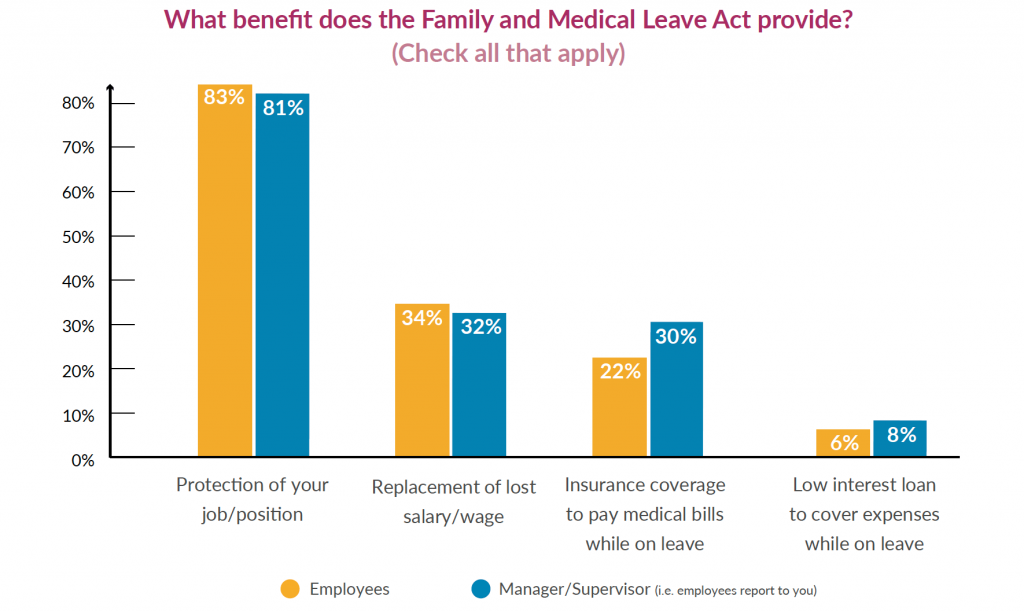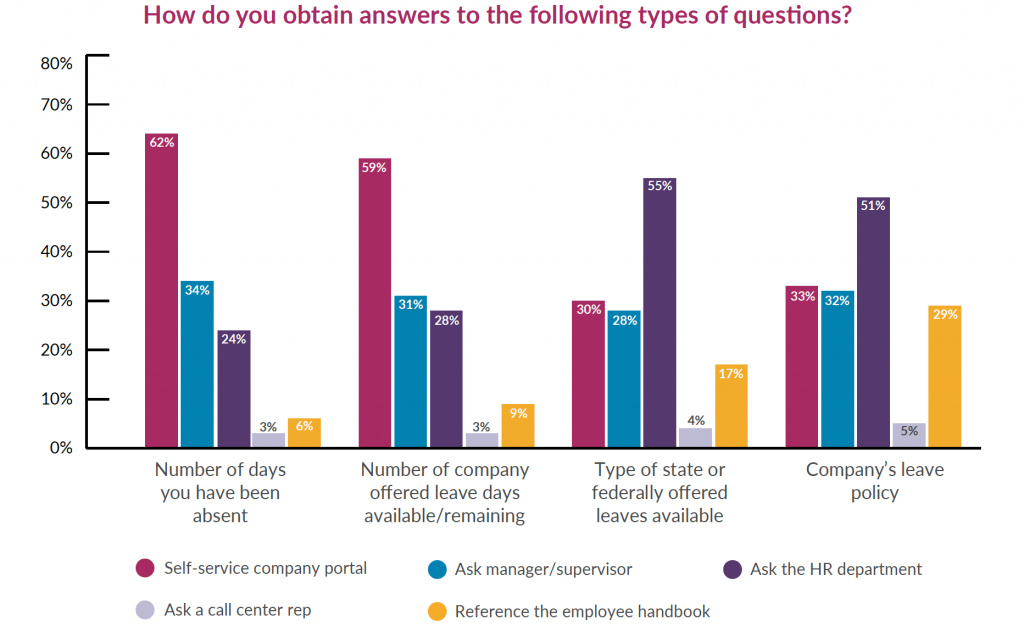By Angie Brown, Absence Practice Leader
February 25th, 2021
Alarmed by the results of the 2019 employee/manager FMLA Knowledge Gap survey with regard to the lack of understanding of leave regulations and the employee and compliance challenges due to it, we decided to follow up in 2020 in the hopes of seeing a significant improvement. Leave administration may not be a top of mind or a requirement detailed in most managers’ jobs, but nearly 50% of them surveyed indicated they are asked to educate their employees about leave options — specifically Family and Medical Leave Act (FMLA) and state mandated family and medical leaves. Additionally, they are required to notify their employees of their eligibility for these specific leave benefits. One might think this sounds easy enough, right?
Say, for example, you are a manager for a New York-based employer and you have an employee whose father has suffered a stroke and they inform you they’ll need to be out of work for at least two weeks while they take care of him. You tell them that unfortunately, they only have 7 days of Paid Time Off remaining this year, so they’ll need to return to work when their PTO is up.
Not so fast – you’ve failed to provide notice requirements to this employee relating to the other leave benefits available to them for taking time off work to care for their parent who has a serious health condition. As a New York state employee of a company with more than 50 employees, they’re entitled to job protection under the FMLA. Additionally, they are entitled to apply for New York Paid Family Leave that would provide wage replacement for their time out of work. By not advising this employee of their rights and responsibilities under these leave laws you have inadvertently violated these laws and as a manager you may be held personally liable.
There are two ways this can go in this scenario. The employee could have received no adverse results from the absence, and you will have had to provide him with “free” FMLA (job protection) time, thus not deduct it from his total allotment, allowing him to use it later, or you did. Remember, you made him come back to work during a critical time in his father’s life. Perhaps he chose not to come back and took unpaid time? Perhaps you issued attendance points? You have now critically violated his FMLA rights.
And this scenario is just for one state. Each state has their own set of regulations, with state Paid Family Leave becomingly increasingly common but of course still not available to employees in most states. With so many companies now moving to either permanent or hybrid models of work from home, employees can live and work from anywhere, complicating how you manage leaves of absence.
An Alarming Knowledge Gap Among Managers
For the second straight year, we surveyed front-line managers to better understand how well they understand the Federal Family and Medical Leave Act (FMLA) as well as state Paid Family Leave (PFL), provided they live in one of the states currently offering PFL. Though we slightly tweaked some of our questions from our initial research in 2019 — limiting the direct comparisons from 2020 to 2019 — the numbers continued to paint a bleak picture for managers’ understanding of FMLA and PFL, creating operational and business risk for them and the company.
In order to be deemed “knowledgeable,” managers were required to answer our three questions on FMLA correctly. Of the 435 managers surveyed, just 11% answered all three basic questions correctly, reflecting a significant knowledge gap!
For PFL, we asked two questions to test managers’ knowledge and just 17% of these managers were able to correctly identify the benefits eligible under PFL, including whether they live in a state currently offering PFL.
It would be one thing if these managers weren’t tasked with any responsibility with leave administration at their company, but that’s not the case. The graphic below shows that nearly 50% of managers said they are responsible for educating their employees on these leave benefits and notifying them of their eligibility.
Figure 1: Managers’ responsibilities in leave administration at their employer
 Considering that 30% of managers in the study thought that FMLA provided insurance coverage to pay medical bills while on leave and 32% indicated FMLA provided replacement of lost salary/wage, it is easy to be concerned about having these managers responsible for educating employees on these leave options and benefits. Adding to the complexity and risk for the company is that having one of your managers treat their direct reports differently than another relating to the FMLA is also an FMLA violation. If one manager thinks FMLA can be taken for a family vacation, and another doesn’t, you have a significant compliance issue!
Considering that 30% of managers in the study thought that FMLA provided insurance coverage to pay medical bills while on leave and 32% indicated FMLA provided replacement of lost salary/wage, it is easy to be concerned about having these managers responsible for educating employees on these leave options and benefits. Adding to the complexity and risk for the company is that having one of your managers treat their direct reports differently than another relating to the FMLA is also an FMLA violation. If one manager thinks FMLA can be taken for a family vacation, and another doesn’t, you have a significant compliance issue!
Figure 2: Employees’ and managers’ responses to the benefits provided by FMLA. Note: Respondents could select multiple answers.

We speculated after 2019’s report — in which we did not ask questions about whether managers had received FMLA training — that a lack of training was a major factor in the knowledge gap. Yet after collecting training data from respondents in 2020, we found the knowledge gap among managers was virtually the same, regardless of whether the manager had formal training.
While this is yet another red flag, we did identify some benefits from training. Managers who had received FMLA training were significantly more likely to agree that as managers of employees, they could be sued for FMLA and ADA violations. They were also significantly more likely to agree they are responsible for helping with compliance at their organization.
What Role Does Technology Play in Educating Managers and Employees?
Customer portals are becoming commonplace for large employers as well as insurance companies — recent Majesco research found that insurers are heavily focused on customer self-service capabilities and portals, with 41% to 61% of companies saying they are implementing or have already implemented these.
While these portals can be used for a multitude of reasons, they can be a tremendous resource for employees and managers when it comes to tracking and reporting absences. Our research found that self-service company portals are employees’ preferred method to obtaining answers to the number of days they’ve been absent and the days they have remaining. But when it comes to more detailed questions, such as the type of state of federally offered leaves available, employees are more apt to seek out this answer by contacting their HR department.
Figure 3: Where do employees go for their leave questions?

The benefits of an effective and informative self-service portal are substantial. Having a devoted platform where employees and managers can access this information 24/7 could play a pivotal role in ensuring both employees and managers are well-educated in the state and federal leaves available to them. Paired with a software that can automatically determine an employee’s eligibility for these leaves based on built-in regulations is the type of error-proof compliance solution needed in the market. Hence the rising demand in absence and accommodation management software that employers can use or insurance companies can provide as a “value added service” to their employer customers.
Insurance companies who are providing this offering, or are in the process of enhancing their portal, are well-positioned to be a go-to solution for helping employers mitigate their compliance risk and improve their leave management offering.
How Should Employers Address This Knowledge Gap?
As you might expect, there’s no silver bullet for solving this Knowledge Gap. For some companies, the Knowledge Gap may not be as substantial. And the approach to address this gap for one employer may not work for another. Take employer size and location, for example. An employer with more than 10,000 employees that has offices all across the U.S. is going to have a much more complicated workforce to manage absences than that of a 200-person company operating in a single state. And as noted before, the rising acceptance of work from home will accelerate this complexity.
Balancing multiple state Paid Family Leaves alongside other local, state, and federal leave laws, and any corporate leaves, is a lot for anyone whose full-time job is absence management. While no one is expecting these managers to have the same set of knowledge as those individuals, it probably doesn’t come as a surprise that managers who have a substantial list of their own day-to-day duties are struggling to correctly identify FMLA and PFL details. Simply allowing these managers to continue to play a role in leave administration without proper education isn’t the answer, though.
While our study found the existing training structure isn’t proving to be an effective way of educating managers, we heard through interviews with them that these training sessions were infrequent and covered a wide range of topics — they weren’t specific to leaves such as FMLA. Evaluating whether the existing training at your company is focused enough and effective with your staff is a great starting point.
For some employers, though, part of the answer may be to look to an insurance carrier or third-party administrator for a new “value added” service. Although it doesn’t absolve your managers of responsibility, outsourcing leave administration to insurers or TPAs is becoming increasingly common among employers. Insurance companies and TPAs have the resources and technology to optimize the business process and ensure compliance with these laws.
For a complete picture of the FMLA & PFL Knowledge Gap in 2020, you can download the report here.
This blog originally appeared on Majesco.




